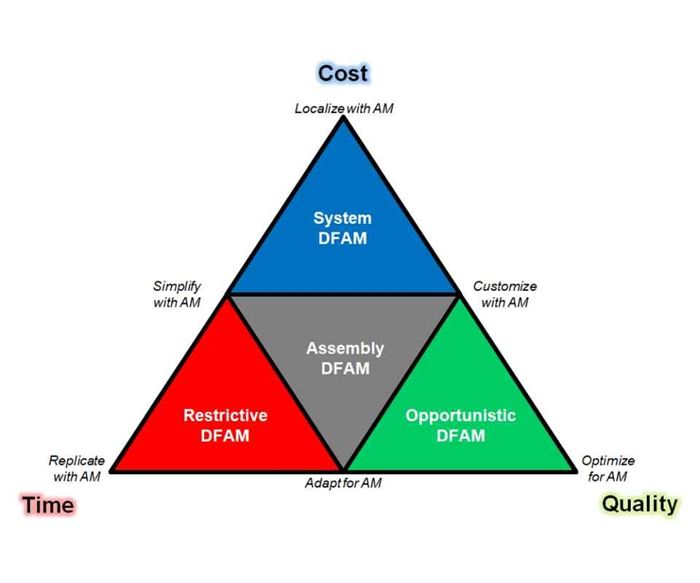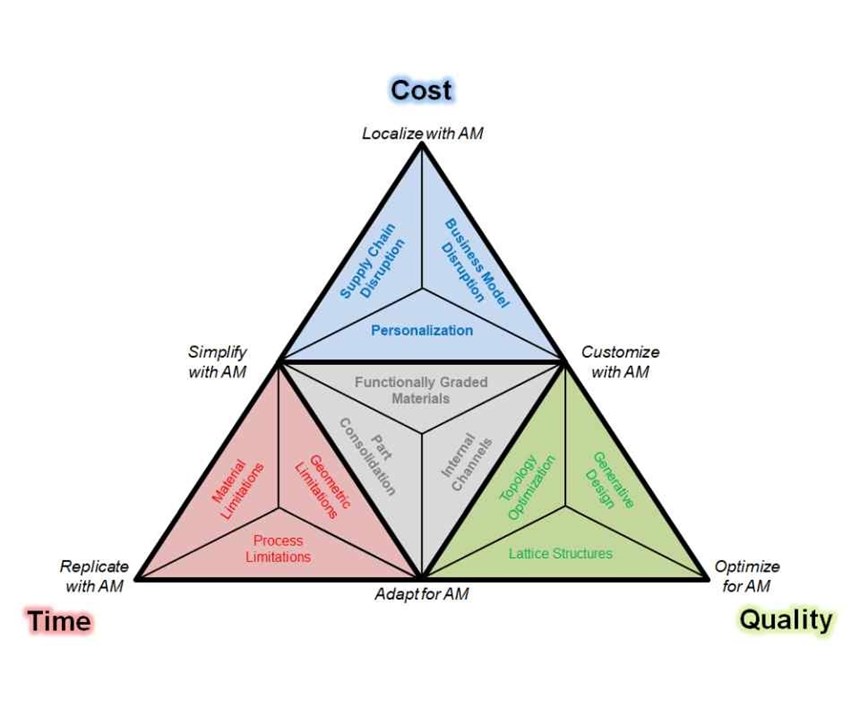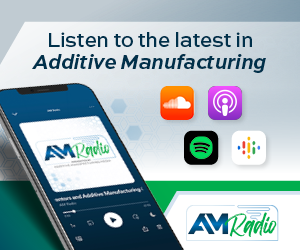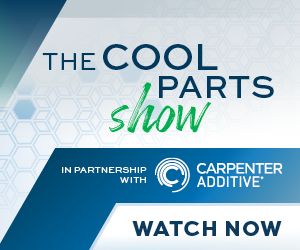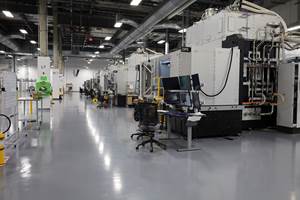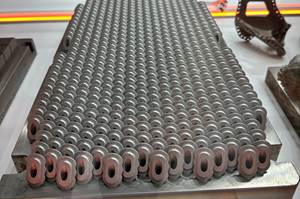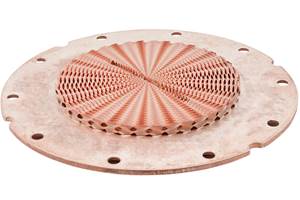Finding the Value Proposition for Additive Manufacturing
Why would anyone want to use additive manufacturing?
Share
Read Next
Additive manufacturing (AM) provides design and material freedoms for making parts that are impossible or too expensive to fabricate with traditional manufacturing processes such as milling and casting. Although design for additive manufacturing (DFAM) has its limitations, it also enables new opportunities like lattice structures, conformal cooling channels and more.
We often think only at the part level for DFAM, but it can be applied at the assembly and system levels as well (see first figure above), and different benefits accrue at the different levels. The many possibilities of AM outweigh the limitations.
“We aren’t going to fly a 3D-printed part just because it’s cool. It has to buy its way onto the engine just like any other part.”
Yet being enamored with these attractive possibilities—the “what” and the “how” of AM—still doesn’t get us to the “why,” the ultimate reason for using AM. It has to deliver on a value proposition. As William Brindley from Pratt & Whitney once told me, “We aren’t going to fly a 3D-printed part just because it’s cool. It has to buy its way onto the engine just like any other part.”
Cost is only one factor that potentially drives this acceptance. Quality and time (speed) are the other two main drivers, and AM can help improve all of these when used effectively. For instance, lattice structures can be used to create lighter-weight components with better strength-to-weight ratios. This improves part quality while reducing the cost of AM by using less material and build time to make the part. This may even enable a material substitution, improving the life and durability of the part. In medical applications such as implants, lattice structures improve osseointegration, which improves bond strength and helps patients recover faster. Over time, this leads to fewer implant revisions, fewer replacements and ultimately fewer surgeries.
Topology optimization also can be used to create lightweight structures for aerospace or space structures. Why is light weight good in these applications? I have seen estimates that saving 1 kilogram of weight on a plane saves $3,000 a year in fuel costs. In space applications, the savings jumps to $10,000 per kilogram of weight saved, or the company can trade the weight savings to haul more payload, making the launch more profitable. Companies also save money because they improve their material-use buy-to-fly ratio, which I have seen as high as 80-to-1 in some cases. Less material is needed to make a topology-optimized component, reducing material costs and build time, and less scrap is produced.
AM also can be used for functional prototyping and replacement parts. This gives companies a speed advantage, improving flexibility and agility by reducing product development time and manufacturing lead time. Printing replacement parts on demand can reduce inventory carrying costs in companies and improve logistics and support in military operations, especially in remote locations.
Reduced tooling needs make AM useful for customized parts and components. This enables new “manufacturing as a service” business models that entrepreneurs and startups can exploit for low-volume production runs of customized product offerings. Larger companies can use AM to print custom tooling, fixtures, patterns and molds for low-volume production runs.
Part consolidation reduces assembly time as well as labor costs. It also can reduce procurement costs and supply-chain complexity. Part consolidation can improve the structural integrity of parts and reduce possible leakage points in manifolds and other high-pressure applications.
AM can produce intricate internal channels to lightweight components or improve heat-transfer efficiency in piston crowns or turbine blades. Conformal cooling channels inside an injection-molding tool can speed production by improving cooling efficiency. The surface roughness inherent in AM builds actually helps improve the heat-transfer efficiency of heat exchangers, opening avenues for new geometries that better conform to their use.
By bringing AM in house, companies often can gain additional leverage over their supply chains, reducing procurement costs. Testing and component validation can be expedited. Inventory costs can be reduced by moving to digital inventories that leverage AM’s on-demand manufacturing capabilities, like printing when you need it. This increases flexibility by making the company more nimble in response to fluctuations in the market. Companies then can deliver products more quickly or deliver a higher-quality product closer to when it is needed.
The benefits of AM are many, and the challenge arises because the value proposition can vary widely by application, company and industry. Understanding the opportunities as well as the restrictions is important to getting the most out of AM and ensuring that your part will fly not just because it is cool, but also because it brought value to the end product just like everything else.
Related Content
VulcanForms Is Forging a New Model for Large-Scale Production (and It's More Than 3D Printing)
The MIT spinout leverages proprietary high-power laser powder bed fusion alongside machining in the context of digitized, cost-effective and “maniacally focused” production.
Read MoreSemiconductors, Tungsten, AM Affordability and More from Formnext 2024: AM Radio #56
The trade show included increased applications for the semiconductor market, machine launches and technology advances aimed at cost cutting, plenty of LFAM and more. Listen to our conversation on Formnext 2024.
Read More8 Cool Parts From Formnext 2023: The Cool Parts Show #65
New additive manufacturing technologies on display at Formnext were in many cases producing notable end-use components. Here are some of the coolest parts we found at this year’s show.
Read MoreWith Electrochemical Additive Manufacturing (ECAM), Cooling Technology Is Advancing by Degrees
San Diego-based Fabric8Labs is applying electroplating chemistries and DLP-style machines to 3D print cold plates for the semiconductor industry in pure copper. These complex geometries combined with the rise of liquid cooling systems promise significant improvements for thermal management.
Read MoreRead Next
Profilometry-Based Indentation Plastometry (PIP) as an Alternative to Standard Tensile Testing
UK-based Plastometrex offers a benchtop testing device utilizing PIP to quickly and easily analyze the yield strength, tensile strength and uniform elongation of samples and even printed parts. The solution is particularly useful for additive manufacturing.
Read MoreAlquist 3D Looks Toward a Carbon-Sequestering Future with 3D Printed Infrastructure
The Colorado startup aims to reduce the carbon footprint of new buildings, homes and city infrastructure with robotic 3D printing and a specialized geopolymer material.
Read MoreCrushable Lattices: The Lightweight Structures That Will Protect an Interplanetary Payload
NASA uses laser powder bed fusion plus chemical etching to create the lattice forms engineered to keep Mars rocks safe during a crash landing on Earth.
Read More

